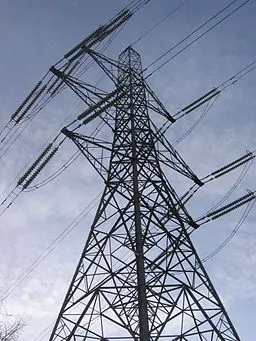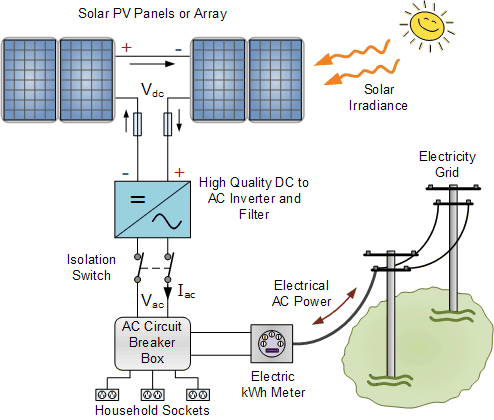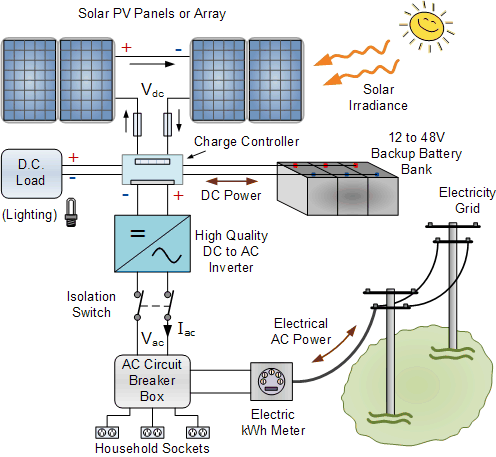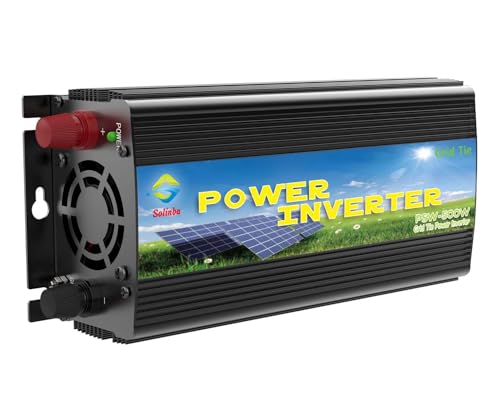Grid Connected PV System
Connecting your Solar System to the Grid
![]() A grid connected PV system is one where the photovoltaic panels or array are connected to the utility grid through a power inverter unit allowing them to operate in parallel with the electric utility grid.
A grid connected PV system is one where the photovoltaic panels or array are connected to the utility grid through a power inverter unit allowing them to operate in parallel with the electric utility grid.
In the previous tutorial we looked at how a stand alone PV system uses photovoltaic panels and deep cycle batteries to store its solar energy providing a complete self-contained solar power system. However, this type of solar system works fine providing there is enough solar radiation during the day to recharge the batteries for use during the night.
Stand alone solar systems are self contained fixed or portable solar PV systems that are not connected to any local utility or mains electrical grid as they are generally used in remote and rural areas. This generally means that the electrical appliances are a long way from the nearest fixed electrical supply, or were the cost of extending a power line from the local grid may be very expensive.

Grid Connected PV
In recent years, however, the number of solar powered homes connected to the local electricity grid has increased dramatically. These Grid Connected PV Systems have solar panels that provide some or even most of their power needs during the day time, while still being connected to the local electrical grid network during the night time.
Solar powered PV systems can sometimes produce more electricity than is actually needed or consumed, especially during the long hot summer months. This extra or surplus electricity is either stored in batteries or as in most grid connected PV systems, fed directly back into the electrical grid network.
In other words, homes and buildings that use a grid connected PV system can use a portion or all of their energy needs with solar energy, and still use power from the normal electrical mains grid during the night or on cloudy dull and rainy days, giving the best of both worlds. Then in grid connected PV systems, electricity flows back-and-forth to and from the mains grid according to sunlight conditions and the actual electrical demand at that time.
In a grid connected PV system, also known as a “grid-tied”, or “on-grid” solar system, the PV solar panels or array are electrically connected or “tied” to the local mains electricity grid which feeds electrical energy back into the grid.
The main advantage of a grid connected PV system is its simplicity, relatively low operating and maintenance costs as well as reduced electricity bills. The disadvantage however is that a sufficient number of solar panels need to be installed to generate the required amount of excess power.
Since grid tied photovoltaic systems feed their solar generated electricity directly back into the utility grid when not needed for self-consumption. Expensive back-up batteries are not necessary and can therefore be omitted from most grid connected designs.
Also, as this type of PV system is permanently connected to the grid, solar energy consumption and solar panel sizing calculations are not required, giving a large range of options allowing for a system as small as 1.0kWh on the roof to help reduce your electricity bills, or a much larger floor mounted array that is large enough to virtually eliminate your electricity bills completely.
Grid Connected Net Metering
Connecting solar panels together to make larger array’s for connecting directly to the local power grid enables you to engage in one of the most advantageous parts of generating your own electricity: Net Metering or Net Billing.
If during a sunny day more electricity is produced by your solar PV system then you use or consume, this excess solar power is delivered back to the utility grid with the effect of rotating your electric meter backwards. When this happens you will normally be given credits by the local power company for the amounts of electricity produced by your grid connected PV system.
If during the billing period you use or consume more electrical energy than you generate, you are billed for the “net amount” of electricity consumed as you would be normally. If, however, you generate more solar energy than you consume, you are credited for the “net amount” of electricity generated which may be either a reduction in your monthly electricity bill or a positive repayment directly to you or the account holder.
When installing a PV system, if net metering is available by your local electricity company, you may be required to install a new second electrical meter instead of using a single electricity meter that spins in both directions.
This new meter allows for a measurement of net energy consumption, both entering and leaving the system and would be used to reduce your electricity bill. However, each electrical utility company has its own policy regarding the buying back of energy generated by your own small solar power station.
While net metering is the ideal way to resell your solar generated excess power, some companies buy-back energy at a lower wholesale rate than the electricity you consume from the same power company. This means that you may need to generate more solar power than you would normally consume just to break even.
Simplified Grid Connected PV System

Grid connected PV systems always have a connection to the public electricity grid via a suitable inverter because a photovoltaic panel or array (multiple PV panels) only deliver DC power. As well as the solar panels, the additional components that make up a grid connected PV system compared to a stand alone PV system are:
Component Parts Of A Grid Connected PV System
- Inverter – The inverter is the most important part of any grid connected system. The inverter extracts as much DC (direct current) electricity as possible from the PV array and converts it into clean mains AC (alternating current) electricity at the right voltage and frequency for feeding into the grid or for supplying domestic loads.
It is important to choose the best quality inverter possible for the budget allowed as the main considerations in grid connected inverter choice are: Power – Maximum high and low voltage power the inverter can handle and Efficiency – How efficiently does the inverter convert solar power to AC power. - Electricity Meter – The electricity meter also called a Kilowatt hour (kWh) meter is used to record the flow of electricity to and from the grid. Twin kWh meters can be used, one to indicate the electrical energy being consumed and the other to record the solar electricity being sent to the grid.
A single bidirectional kWh meter can also be used to indicate the net amount of electricity taken from the grid. A grid connected PV system will slow down or halt the aluminium disc in the electric meter and may cause it to spin backwards. This is generally referred to as net metering. - AC Breaker Panel and Fuses – The breaker panel or fuse box is the normal type of fuse box provided with a domestic electricity supply and installation with the exception of additional breakers for inverter and/or filter connections.
- Safety Switches and Cabling – A photovoltaic array will always produce a voltage output in sunlight so it must be possible to disconnect it from the inverter for maintenance or testing. Isolator switches rated for the maximum DC voltage and current of the array and inverter safety switches must be provided separately with easy access to disconnect the system.
Other safety features demanded by the electrical company may include earthing and fuses. The electrical cables used to connect the various components must also be correctly rated and sized. - The Electricity Grid – Finally the electricity grid itself to connect too, because without the utility grid it is not a Grid Connected PV System.
An grid connected system without batteries are the simplest and cheapest solar power setup available, and by not having to charge and maintain batteries they are also more efficient. It is important to note that a grid connected solar power system is not an independent power source unlike a stand alone system. Should the mains supply from the electrical grid be interrupted, the lights may go out, even if the sun is shining. One way to overcome this is to have some form of short term energy storage built into the design.
Grid Connected System with Battery Storage
A small scale photovoltaic solar system that has storage batteries within its design, also operates in conjunction with the local electricity company. The short-term peak demand is met by the battery without drawing from the grid and paying the extra charge.
When used in grid connected PV systems, Deep Cycle Batteries can be classified into short term storage for a few hours or days to cover periods of bad weather and long term storage over several weeks to compensate for seasonal variations in the solar irradiation between the summer and winter months.
Incorporating batteries into a grid connected system for Energy Storage requires more components, is more expensive, and lowers the systems overall efficiency. But for many homeowners in remote areas who regularly experience a loss of their grid supply during bad weather conditions or have critical electrical loads that can not be interrupted, having some form of backup energy storage within their grid connected system can be a great benefit.
Grid Connected PV System with Battery Storage

So we can see from above, that a PV system with battery storage is basically the same as for the previous grid connected PV system with the addition of the batteries and charge controller. The battery charge controller, determines whether the power generated by the solar panels is needed for home use, to run low voltage equipment and lighting or whether it will charge the deep-cycle backup batteries to be used later on.
The DC current leaving the controller passes through the DC to AC inverter, transforming it into electricity usable by general household appliances. Any surplus electricity not being consumed or used by the home can be sent to the electricity companies power grid. It is better to run DC rated lighting and appliances first directly off your solar system before the current is converted to AC from the inverter. This will gain the most efficiency.
Living with a grid connected solar PV system is no different than living with just the normal grid power, except that some or all of the electricity that is consumed comes from the sun. PV solar systems designed for grid connection are usually designed to meet at least half of a homeowners electrical needs.
Grid Connected System – An Overview
Purchasing a home solar photovoltaic panel array large enough to supply the entire electrical needs of a home would be extremely expensive with the solar array taking up a large amount of space. The solar power generated by a grid connected system is therefore only partial, with the remaining energy being made up by the power company.
The advantage of a Grid Connected PV System, either with or without storage batteries is that on clear blue sunny days, when the photovoltaic system is producing large amounts of current and the home is consuming low energy levels, for example, if you are out of your home all the day working, you’re solar system keeps generating electricity.
The excess electricity generated does not go to waste but is fed back into the power grid to be used by your neighbouring homes who unknowingly end up using the clean, renewable energy themselves while making money for you through your “net metering” arrangement.
In the next tutorial about “Solar Power”, we will see that a Solar Inverter can be used to transform the DC voltages and currents of a typical solar panel into an alternating AC voltage suitable for feeding directly into the power grid.










Great Article
Can we have more articles about HVRT, LVRT and islanding
Great post! I’m really interested in learning more about grid-connected PV systems and how they work. Can you elaborate on the benefits of connecting PV panels to the grid? How does it affect the overall efficiency of the system?
Looking for solar grid system
what about the panels that use an inverter for each panel and produces 240 volt AC?
What about “the panels that use an inverter for each panel and produces 240 volt AC?”
Iam greatful,though l have a question during grid connection ,is back up neccesary during installation?
what type of transformer is needed in a grid tied pv system with battery, could it be a low, medium or high power transformer
Transformers are not used for a grid-tied pv system as the inverter connects directly to the utility grid
Great article! I am curious to know if it is possible to run energy generated from a PV array back to the main panel via existing wiring such as parking lot lighting or EV charging stations? Or would another trench need to be dug and cable laid?
Clearly the answer to your question would depend on your actual installation, which we have no knowledge of. The use of existing wiring would require that any cables used are of sufficient diameter (AWG) to safely carry the generated current.
When switching from PV system back to the electrical supply from the regular grid, will this increases the maximum demand (from the regular grid provider) if compare to the system that just using the regular grid?
It will depend on what contract you have with the utility company of your regular grid. The electrical demand will be the same for the load connected to a pv system or the grid.
Just for an example, let say my max. demand generally will be around 1800kW every month when constantly using the power supply from the regular. So, when we use the power supply from our own PV grid, and then we will switch to the regular grid at 3pm on daily basis, will this cause some kind of high in rush current? Hence, will generate higher max. demand?
IN GRID CONNECTION ARE THE BATTERIES NOT NECCESSARY
For a grid connected system, batteries are optional, but can be useful to store energy during the day and use their stored energy at night instead of the utility grid. Then the grid becomes a back-up energy source if the batteries do not fully charge during the day (cloudy weather) or the night time power consumption is greater than the batteries Ah rating. Usually the power taken from the utility grid is more expensive than what they give you back for self generation, then in some circumstances can make economical sense.
ok
Hi Admin,
Thanks for posting this information about grid-connected PV systems. I am searching for ways to be grid-connected while having a battery as a back up. Though my setup is hybrid, there are still really some challenges most especially to the local utilities since they need to consider so many things before approving my setup. But either way, I’m glad you posted this.
Thanks.
INDEED, GRID-TIE INVERTER (GTI) SOLAR POWER GEN. SYSTEM IS THE MOST EFFICIENT AND CHEAPEST THOUGH NOT MOST RELIABLE SINCE WHEN THE UTILITY IS OUT THEN POWER FLOW TO THE LOADS ARE HALTED AND BURDEN SOME EVEN THOUGH THE SUN IS UP AND SOLAR PV PANELS ARE GENERATING ELECTRICITY. HOWEVER, WITH THE ADVENT OF HYBRID INVERTER THEN SOLAR POWER USAGE AND IN TANDEM WITH THE LOCAL UTILITY GRID CAN BE DEPENDABLE EVEN DURING NIGHT A SWELL AS DAYTIME BUT WITH THE NEEDED STORAGE BATTERIES BUT WITH ADDITIONAL COST OF INVESTMENT.
pl furnish more information about anti islanding facility in grid connected solar projects 10 mw and above
Your article is very informative. Thanks a lot for building my concept on grid-connected system.
According to the study’s co-author, despite the increases, the U.S. gets less than 1% of its electricity from solar power.
Can I simply plug my inverter into a receptacle while grid power is on ?
In theory yes, but it needs to be a type that can safely synchronise itself to the frequency and phase of the mains. Also, your mains wiring to the plug socket, and the plug socket itself, needs to be able to handle the power from the inverter. There are companies that sell photovoltaic systems that you can plug directly into the wall socket.
If the power goes out of the grid, can this system automatically switching power from the batteries? If not, then what other things need to be done?
That depends on the inverter you have. Most better quality inverters would detect the blackout and carry on supplying power from the solar array or batteries if there was a power shortage. Like with most things, you get what you pay for.
I really like the information provided in this article. thanks you for improving my skill toward these.
Everything is very open with a really clear description of the challenges. It was really informative. Your site is very helpful. Many thanks for sharing!
i want to how I can design solar panel in grid interconnection
I’d like my son to see this. Is there a pdf or similar that I can send as attachment or such to him. Thanks.
Hi Sherry,
Thank you for your question.
These tutorials are only available free online, sorry there is no hard copy or pdf version.
You can always send him the URL link to this tutorial or site though.